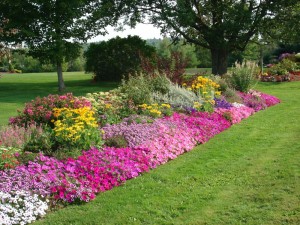





A flower border is not a natural habitat but a garden feature, and it can be planted to provide plenty of food for wildlife and to act as a refuge for several of the more attractive wildflowers. Many cultivated non-native garden flowers are rich in nectar and provide food for bees, bumblebees and butterflies, and as a result many of our gardens, planted with no thoughts of attracting wildlife, are full of bees and butterflies.
 Flowering plants are best placed in full sun if you want them to attract the maximum number of bees and butterflies. Choose a sheltered, sunny site that can be easily viewed from the house or patio. Flower borders normally consist of a mixture of native and non-native plants. Most gardeners want to include their favourite flowers in a border, and do not worry whether they are native or introduced. If planting for bees and butterflies, choose single-flowered cultivars, because the design of these blooms makes it easier for the insects to reach the nectar.
Flowering plants are best placed in full sun if you want them to attract the maximum number of bees and butterflies. Choose a sheltered, sunny site that can be easily viewed from the house or patio. Flower borders normally consist of a mixture of native and non-native plants. Most gardeners want to include their favourite flowers in a border, and do not worry whether they are native or introduced. If planting for bees and butterflies, choose single-flowered cultivars, because the design of these blooms makes it easier for the insects to reach the nectar.
You can, however, plan a border using just plants that are native to your local area. For example, the following scheme can be particularly effective for slightly damp soils: grow Cardamine pratensis (lady’s smock), Lychnis flos-cuculi (ragged robin) and Saponaria officinalis (soapwort) in the front of the border, and Filipendula ulmaria (meadow-sweet), Eupatorium cannabinum (hemp agrimony) and Lythrum salicaria (purple Lychnis flos-cuculi) at the back. All these suggested plants prefer a fertile, well-drained soil. A native border always looks more natural with a hedge or shrubs as a backdrop, rather than a brick or stone wall, which makes it look more formal.
There are several species of wild flower that are now so rare in the wild that they are protected by law, making it illegal either to pick the flowers or to dig up the plants in the wild. Some of these, however, make excellent garden plants, including Dianthus gratianopolitanus (Cheddar pink) — a lovely plant of limestone areas, but one that is easy to cultivate in well-drained alkaline soil. Many such rare and endangered plants can be legally obtained by gardeners from specialist nurseries, and it could be very rewarding to plant a bed or beds with endangered plants and so create your own wildflower refuge. In this way, you will also be helping in the conservation of the species. Check which plants are likely to grow in your soil by contacting your local conservation group and be sure to get plants or seed from a guaranteed local source.
Hints and Tips
Try to include some plants that flower either early or late in the season, so that the potential for attracting bees and butterflies is maximized.
Regular dead-heading will keep the flowers coming.
Butterflies and moths are closely related. Butterflies have clubbed ends to their antennae whereas moth antennae are pointed. The adult butterflies fly by day, seeking nectar, whereas moths usually fly after dark. When butterflies mate, the female lays her eggs either on or beside the appropriate food plant for the larva stage — the caterpillar. When the caterpillars are large enough, they pupate and the adults emerge. Common butterflies that may be seen in gardens are peacocks, red admirals, small tortoiseshells and cabbage whites.
Butterflies will visit any garden where there is a range of nectar-rich plants, provided that they are able to breed in the area. For this to occur, they are dependent on a good supply of the particular food plants on which their larvae feed. Caterpillars, however, are very specific about their food plants: many will feed on only a single species of plant and most diet on just a few closely related plants.
Planting a range of caterpillar food plants will ensure that you can enjoy watching the adult butterflies, which are less fussy and happy to visit a wide range of both ornamental and native plants for nectar.
Copyright © www.100flowers.win Botanic Garden All Rights Reserved